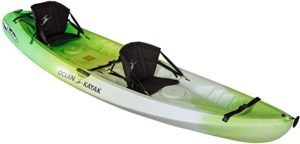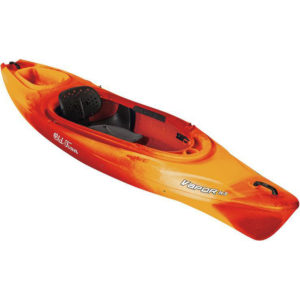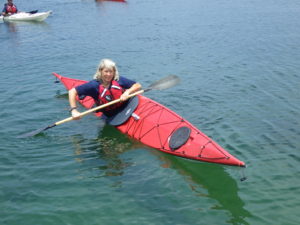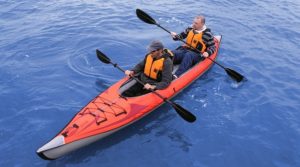Drowning: The best way to prevent this hazard is to wear a properly adjusted PFD (Personal flotation device). Anyone venturing into the open ocean without a trained guide should should be a confident swimmer.
Sting rays: San Diego’s beaches attract sting rays, especially in the summer. These are easily avoided by doing the “Sting Ray Shuffle” and shuffling your feet across the sand when wading. The sting rays will get out of your way! If you lift your feet while wading and step on one, it will defend itself with the sharp barb on the end of it’s long tail. This barb contains a toxin that is not harmful, but extremely painful. The only relief is to soak in very hot water for about an hour. After that, provide quality normal wound care for dirty cuts and monitor for infection. The Lifeguard tower is equipped with buckets of hot water and first aid supplies.
High speed impacts with hard objects: Breaking waves near shore accelerate kayaks and other vessels rapidly towards swimmers, other kayaks, rocks, and shore. Depending on the size of the breaking waves, resulting impacts may just be bumps and bruises, or broken and dislocated bones. An 80lb kayak surfing a 2′ wave and impacting a child can be devastating. Collisions can be avoided by:
- Only launching and landing in conditions that match your skill level. While a skilled paddler can maintain control in 4-6′ waves, beginners will find 2′ waves challenging.
- Only launch and land when there are no other water users in the path ahead of you, and when the areas on either side are also clear. Special care should be taken when landing. If a wave inadvertently surfs your kayak, you will have no control.
- If you get knocked off your kayak, move to the ocean side of it so the next wave won’t slam it into you. If possible, hold onto it so it doesn’t surf towards other water users, but beware of grabbing ropes attached to the kayak as they can damage your hands.
- Do NOT enter caves or paddle close to rocks when there are any breaking waves present. Keep in mind that much larger “sets” of waves may appear “out-of-nowhere” every 5 minutes, or every 45 minutes. Expect the unexpected!
Temperature extremes: We are blessed in southern CA to have such a mild climate that serious hyper- and hypothermia are not common. However, water and air temperatures in the winter can be quite cold and prolonged exposure can lead to death. Wetsuits are recommended in the winter, but even a windbreaker can slow heat loss. Stay close to shore, pay attention to changing weather conditions, and limit your time on the water. Don’t kayak in the winter if you haven’t practiced re-mounting your kayak in deep water.
Sun: Sunscreen, hats, and protective clothing are important safety measures. If your paddling a sit-on-top kayak, your shins at tops of your feet are particularly susceptible to sunburn. Consider the environment when enjoying our beaches and opt for protective clothing instead of chemical sunscreens whenever possible.
 Sit-on-top kayaks (SOTs): These are a hollow, (mostly) sealed shell of plastic that the paddler literally sits on top of in a seat well. The seat well and any other indentations will have scupper (drain) holes so that any water that comes over the top will drain out. This is important, because even a small amount of water can decrease the stability of a kayak significantly. While SOTs are meant to be sealed, water always seems to find its way through the pin-prick holes and gaps that are inevitable in mass production. A drain hole will be installed so that this water can be drained when it accumulates sufficiently. Forgetting to tighten the drain plug, or a bigger hole or gap (often caused by wear) can cause dangerous levels of water and destabilization to the point that it’s impossible to paddle. With proper attention to the care of your SOT kayak, these are by far the safest type on the open ocean without the significant training and skill required to handle sea kayaks.
Sit-on-top kayaks (SOTs): These are a hollow, (mostly) sealed shell of plastic that the paddler literally sits on top of in a seat well. The seat well and any other indentations will have scupper (drain) holes so that any water that comes over the top will drain out. This is important, because even a small amount of water can decrease the stability of a kayak significantly. While SOTs are meant to be sealed, water always seems to find its way through the pin-prick holes and gaps that are inevitable in mass production. A drain hole will be installed so that this water can be drained when it accumulates sufficiently. Forgetting to tighten the drain plug, or a bigger hole or gap (often caused by wear) can cause dangerous levels of water and destabilization to the point that it’s impossible to paddle. With proper attention to the care of your SOT kayak, these are by far the safest type on the open ocean without the significant training and skill required to handle sea kayaks. Recreational Kayaks: These are popular among beginners because they have a very large seating or “cockpit” area, recessed down into a hollow open shell. Recreational kayaks are mass-produced much like plastic garbage barrels and have become incredibly cheap. Unfortunately, their design makes them extremely dangerous in open ocean conditions and in waves where they can take on water to the point of sinking. Even if they don’t sink, deep-water re-entry after a capsize is virtually impossible without outside help, making them very poorly suited for La Jolla except on the calmest days and close to shore within sight of the lifeguard towers.
Recreational Kayaks: These are popular among beginners because they have a very large seating or “cockpit” area, recessed down into a hollow open shell. Recreational kayaks are mass-produced much like plastic garbage barrels and have become incredibly cheap. Unfortunately, their design makes them extremely dangerous in open ocean conditions and in waves where they can take on water to the point of sinking. Even if they don’t sink, deep-water re-entry after a capsize is virtually impossible without outside help, making them very poorly suited for La Jolla except on the calmest days and close to shore within sight of the lifeguard towers. Sea Kayaks: Sea kayaks have a recessed cockpit like recreational kayaks, but it’s much smaller. They also have watertight bulkheads fore and aft to ensure that most of the kayak cannot fill with water. This allows for deep-water re-entry in the event of a capsize. Sea kayaks are also much more narrow than recreational kayaks and this allows a paddler to fit a “spray skirt” over the cockpit area to keep water out in the roughest conditions. With a properly trained paddler, a sea kayak can handle much of what the ocean can dish out. With an untrained paddler, a sea kayak can be just as dangerous as a recreational kayak. It’s essential to learn and practice some basic skills in calm water like exiting in the event of a capsize (panic can keep a paddler from releasing their spray skirt), and deep water re-entry.
Sea Kayaks: Sea kayaks have a recessed cockpit like recreational kayaks, but it’s much smaller. They also have watertight bulkheads fore and aft to ensure that most of the kayak cannot fill with water. This allows for deep-water re-entry in the event of a capsize. Sea kayaks are also much more narrow than recreational kayaks and this allows a paddler to fit a “spray skirt” over the cockpit area to keep water out in the roughest conditions. With a properly trained paddler, a sea kayak can handle much of what the ocean can dish out. With an untrained paddler, a sea kayak can be just as dangerous as a recreational kayak. It’s essential to learn and practice some basic skills in calm water like exiting in the event of a capsize (panic can keep a paddler from releasing their spray skirt), and deep water re-entry. Inflatable kayaks: These range from pool toys, to top-of-the-line expedition worthy kayaks. The more expensive, the better suited to rougher conditions and waves they will be, as well as more resistant to tears and abrasions. Any inflatable that you use on the open ocean should have multiple air chambers in the event that one or more fails. They should be properly inflated to manufacturers specifications.
Inflatable kayaks: These range from pool toys, to top-of-the-line expedition worthy kayaks. The more expensive, the better suited to rougher conditions and waves they will be, as well as more resistant to tears and abrasions. Any inflatable that you use on the open ocean should have multiple air chambers in the event that one or more fails. They should be properly inflated to manufacturers specifications.